
views
Using Portable Heaters
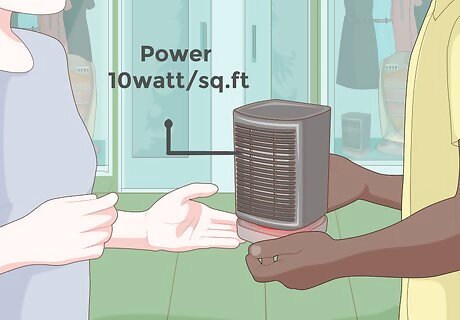
Purchase space heaters if you need an inexpensive heat source. Portable space heaters are the most common tool for keeping individual rooms warm. Plug a heater into a wall outlet to warm up any room right away. As a general rule of thumb, your heater needs to give off 10 watts of heating power for every 1 sq ft (0.093 m) of floor space you wish to heat. Space heaters are efficient but need to be kept about 3 ft (0.91 m) away from walls and flammable surfaces. Space heaters are easy to find and don’t cost much. Most general stores carry them. You can plug in multiple heaters to distribute heat throughout the entire RV. Space heaters are a fire hazard when used incorrectly. Never leave a heater unattended.

Choose a radiant heater for an alternative way to warm small areas. Radiant heaters are very similar to regular space heaters but act more like campfires. Radiant heaters direct warmth in a straight line instead of circulating air. This type of heater is great for heating small areas and rooms you only plan on being in for a short amount of time. For a radiant heater, estimate needing about 10 watts of heating power for every 1 sq ft (0.093 m) of floor space the heat will travel over. A good place for a radiant heater is the bedroom. Point the heater at the bed and let it run overnight. When you leave, turn it off to save energy. Radiant heaters are more expensive than space heaters and still use electricity, which can be a problem in some cases. An average space heater costs $20 to $40 USD, but a radiant heater typically costs at least double that amount. Radiant heaters are not quite as common in stores as space heaters, but you still will probably find them in a lot of general stores. Radiant heaters are less of a fire hazard than space heaters but can still catch nearby objects on fire.
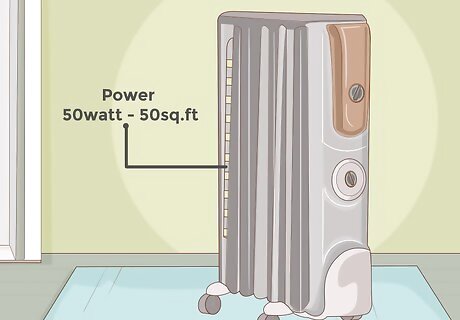
Get an oil radiator if you need to heat rooms for long periods of time. Oil-filled heaters are radiant heaters that operate like space heaters. Plug an oil heater in the wall, then wait for it to heat up. It’s efficient because the oil stays warm at a steady temperature, leading to a steady heat. For a radiator, anticipate needing about 50 watts of power for every 50 sq ft (4.6 m) of floor space. Oil radiators typically cost between $25 and $35. High-end models cost at least double that, which is still less than high-end radiant heaters. You may have a harder time finding a good oil heater in stores than space or radiant heaters. Oil radiators are slow to warm up and cool down. They take 20 to 30 minutes to get running or disperse lingering heat. Oil radiators are less likely to cause fires than other heaters. They still get very hot, although they don’t glow bright red. Avoid setting anything on top of an oil radiator while it is active.
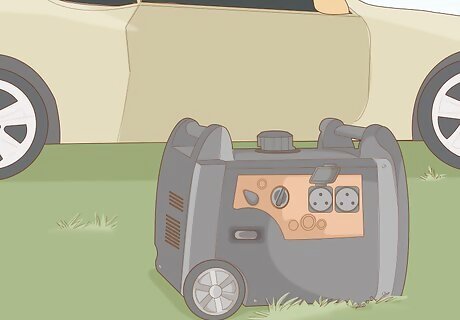
Bring along a generator to power electrical heaters with gas. Portable electrical generators utilize gas or diesel fuel. Using electrical heaters slowly drains your RV’s battery. This can be a problem if you’re boondocking, or spending time in the wild. Set the generator up outside, then plug in your RV or other devices you need to power. To figure out what size generator you need, add up the wattage needed to run the appliances in your RV. With a generator, you need a supply of gas or diesel. Many RV owners have fuel to spare by default, but it is still a consideration to prepare for.
Trapping Heat in the RV

Insulate the walls with curtains or shrink wrap. RV walls aren’t the best at keeping out cold air, so look around for drafts. Windows, in particular, are vulnerable. Cover them with insulated curtains or blinds. You can also fit plastic shrink wrap, reflective insulation, or foam boards to lock more heat inside your RV. You will still need a heat source to warm up your RV, but insulation makes a big difference in keeping your RV warm.
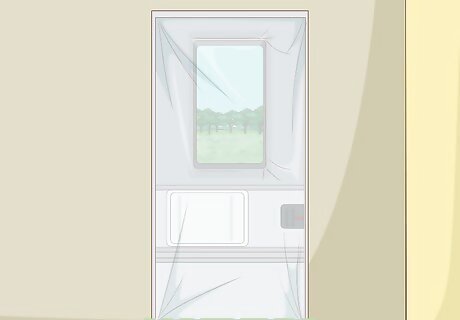
Block off doors with plastic and a draft stopper. Drape plastic shrink wrap or insulated blankets over the interior door. Then, lay the draft stopper against the bottom edge of the door to help insulate it. Remove the protection only when you need to climb out of the RV and put it back as soon as you get inside. Draft stoppers are available at most general stores, but you can also make one by stuffing a sock or other fabric with cotton.
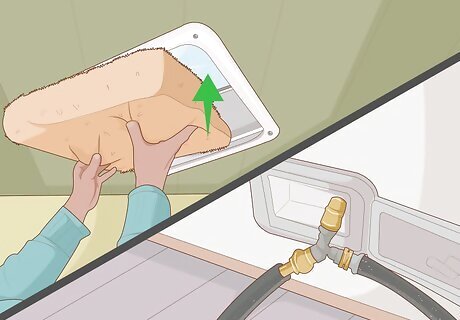
Cover vents and pipes with insulation to stop cold drafts. Purchase some foam insulation or heat tape from a hardware store. Use it to plug the vents in the RV’s roof. If you can get on top of the RV to place the tape, it will be more effective. Also, wrap it around the water pipes underneath your RV to prevent them from freezing. Another option is to purchase a hatch vent insulator from an RV parts supplier. Simply stick it in the vent to block out cold air.
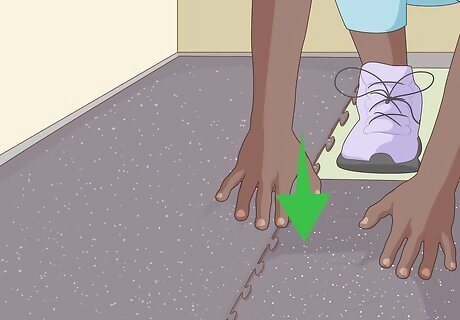
Lay foam flooring on the ground to collect heat. Lay the foam mats in your RV on top of the floor. Put them in large rooms and near heat sources. They absorb heat inside your RV, keeping it warm. They are also soft and more comfortable to step on than a cold hardwood floor. Most general stores and hardware stores sell foam mats.
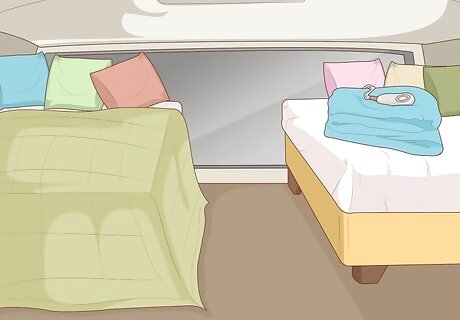
Make electric blankets and down comforters part of your decoration. Electric blankets provide some heat, while down comforters keep heat inside the RV. Use them while you’re in bed or otherwise trying to stay warm. Good blankets are important for times when you can’t rely on a heating system to get all the warmth you need. Down blankets and comforters are great for drafty areas. Hang them over doors and windows as reinforcement, for instance. You can also use hot water bottles. Boil water, pour it in the hot water bottle, then keep it near you for warmth. Electric versions plug into a wall outlet to stay warmer for longer.
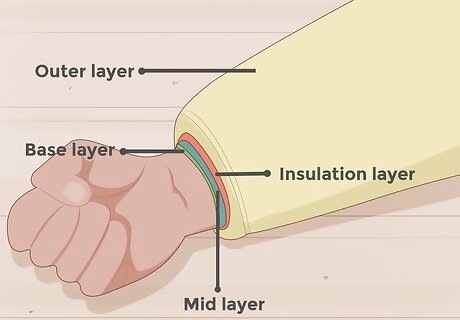
Layer warm clothing to retain heat while you’re inside the RV. Any experienced RV rider knows how important comfy clothing is. Be prepared for the cold by packing long-sleeved clothing. Sweatshirts, sweaters, and cotton pants are a few items to bring, but a down jacket is the best way to stay warm while you’re walking around. Add or remove layers as needed to compensate for the temperature inside the RV. Always pack some spare clothing for warmth. You may not be able to get all the warmth you need from heaters, especially if you’re stuck without working propane heaters.
Installing RV Heating Units
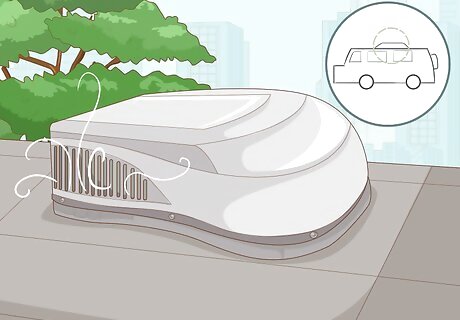
Add electric heat pumps to your RV. Heat pumps fit on an RV’s roof. They make use of the air conditioning system to pump heat in from the outdoors. The pumps run on electricity to produce dry heat. They aren’t extremely powerful and use up plenty of electricity, but don’t need any propane to function. See a mechanic to install a new pump. One of the big downsides is that the pumps can’t operate in temperatures less than about 35 °F (2 °C). In frigid environments, you won’t be able to pump any heat into your RV. Larger RVs often have 2 pumps designed to heat different rooms.
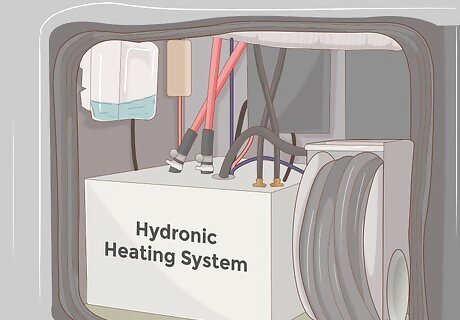
Get a hydronic power system to use less energy heating the RV. Hydronic systems make use of an RV’s water lines to produce heat. Hydronic systems run on electricity or diesel fuel, usually by connecting to an RV’s engine. These heating systems are efficient but also very expensive and complex. You will need an RV mechanic experienced with hydronics to complete an installation. Combining the heating and water systems has a big downside. If your RV’s battery dies, you have to go without both heat and water until you get your vehicle serviced.
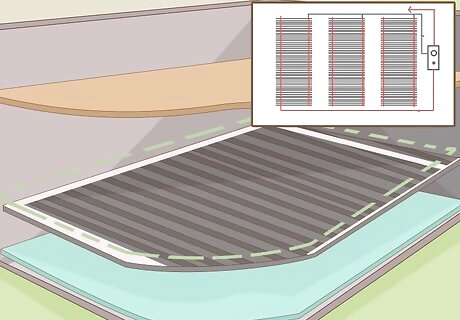
Place radiant flooring inside the RV for an energy-efficient option. With radiant flooring, a mechanic pulls up the floor to lay low-voltage electrical circuits in it. This works a lot better for wider RVs with plenty of floor space. Radiant heating runs on an RV’s electrical system, so you do need a good battery or a hookup to a nearby outlet to keep your RV heated. Radiant flooring is safer than portable heaters and doesn’t add much weight to your vehicle. Radiant flooring may not heat your RV enough in weather below 32 °F (0 °C). Most RVs aren’t well insulated, so the heat escapes. You can avoid some of this by adding insulation.
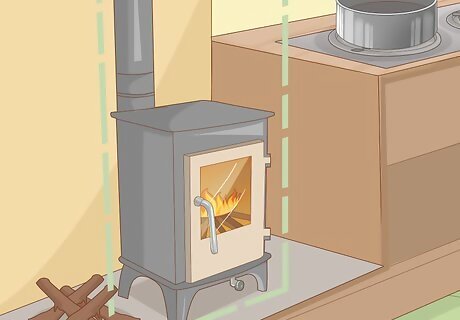
Burn wood in a wood stove if you can’t operate the RV’s heat system. Propane isn’t necessary when you can take advantage of an old-fashioned wood stove. Scrap wood is readily available on most RV trips. Gather some up, put it in the stove, and light it up for free heat. If you only have electrical components in your RV, you won’t be able to take advantage of wood until you visit a mechanic for a professional installation. Wood stoves need to connect to a ventilation pipe leading outside. You can’t bring in a camping stove since carbon dioxide will build up inside your RV. You probably will need to get rid of your regular electric stove to get a wood stove. If this isn’t an option, try installing an electric fireplace. It’s more for ambiance, but it does provide a little extra heat.
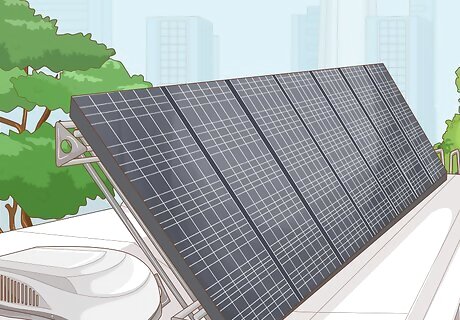
Install solar panels to power heaters while you’re on the road. Have a mechanic set solar panels on top of your RV and connect them to the electrical system. Solar panels don’t provide heat directly, but they do create electricity. This is great for times when campground hookups are unavailable, such as when you’re boondocking. Solar panels keep your RV’s battery full so pumps, space heaters, and other devices stay functional. Solar panels don’t always provide enough electricity. During overcast days, they may not be able to catch much sunlight. You will still need to manage your RV’s power supply or find alternative heat sources. Larger RVs naturally have more space for solar panels. Install multiple panels to create more electricity.
















Comments
0 comment